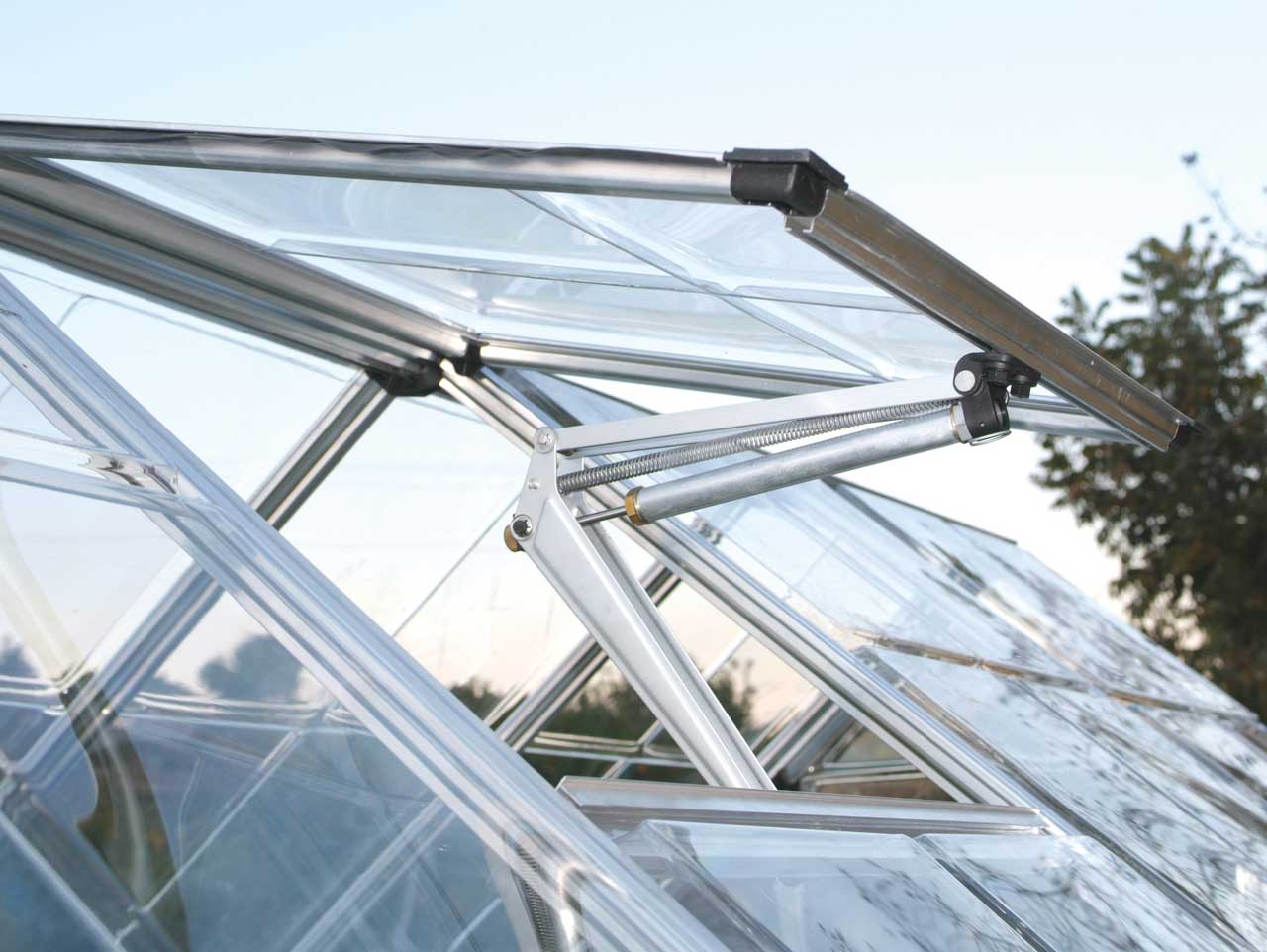
Proper ventilation is essential for a healthy greenhouse environment. It helps regulate temperature, humidity, and air circulation, creating optimal conditions for plant growth. Here are some tips to help you set up greenhouse ventilation effectively:
1. Ventilation Systems:
- Roof Vents: Roof vents are placed at the peak of the greenhouse roof and automatically open to allow hot air and humidity to escape. They are particularly useful in larger greenhouses. Automatic roof vent openers respond to temperature changes, ensuring ventilation even when you’re not around.
- Side Vents: Side vents are located along the sides of the greenhouse. They can be manual or automatic. Manual side vents are opened and closed by hand, while automatic side vents respond to temperature and humidity levels, ensuring consistent airflow.
- Louvre Windows: Louvre windows are slatted windows located on the sides of the greenhouse. They can be opened or closed manually or automatically to control airflow.
- Exhaust Fans: In larger or commercial greenhouses, exhaust fans can be installed to provide additional ventilation. These fans help circulate air and maintain consistent temperature and humidity levels.
2. Placement:
- Place vents and fans strategically to ensure uniform air circulation. Hot air rises, so vents are usually installed near the roof to allow warm air to escape.
- Use both roof vents and side vents to create a natural flow of air. Cold air enters through the lower side vents, while warm air escapes through the roof vents.
3. Automatic Ventilation:
- Consider using automatic ventilation systems such as automatic vent openers and motorized louvre windows. These systems respond to changes in temperature and humidity, ensuring that the greenhouse is ventilated even when you’re not present.
4. Shading:
- Install shading materials such as shade cloth or paint-on shading to reduce excessive sunlight and heat. Excessive heat can build up in the greenhouse, making proper ventilation even more critical.
5. Air Circulation Fans:
- Install horizontal air circulation fans inside the greenhouse to ensure that air is evenly distributed. This helps prevent hot spots and ensures that plants in all areas of the greenhouse receive adequate airflow.
6. Regular Maintenance:
- Clean vents and fans regularly to remove dust and debris, which can hinder proper airflow.
- Check automatic systems periodically to ensure they are functioning correctly. Replace worn-out parts promptly.
7. Temperature Monitoring:
- Use a thermometer to monitor the temperature inside the greenhouse. This can help you adjust the ventilation as needed, especially during extreme weather conditions.
8. Natural Ventilation:
- Whenever possible, utilize natural ventilation methods such as opening doors and vents during mild weather to allow fresh air to circulate.
Proper greenhouse ventilation is essential for the health and productivity of your plants. By setting up a well-designed ventilation system and regularly maintaining it, you can create an optimal growing environment for your greenhouse plants.
Contents
Ventilation with window opener
Automatic window opener

Is it possible to install an automatic window opener in every greenhouse?
The installation of an automatic window opener is possible with all ACD, Palram and Rion greenhouses.
However, these are not always included and must be purchased separately.
How do automatic window openers work?
You do not need electricity for the automatic window opener, because it works with oil.
As soon as it gets warmer in the greenhouse, the oil becomes more liquid and pressure is created in the cylinder. This causes the opener to expand and the window begins to open.
When should I ventilate the greenhouse?
If you have not equipped your greenhouse with an automatic ventilation system, the question naturally arises: when do you need to ventilate your greenhouse at all? It makes less sense in the direct midday sun, as there is less air exchange then. The morning and evening hours are best. If you don’t have the time to air your greenhouse every day, automatic window openers will help.
Also important: you need to ventilate not only in summer, but all year round. In summer, the air in your greenhouse should be able to circulate at all times, if possible. This ensures that it is not too humid and not too dry.
In winter, you should always make sure to keep the windows closed at night. If the temperature is too high during the day, you can open the windows briefly to circulate the air. The perfect companions for your greenhouse in winter are a frost monitor and a greenhouse heater.
TIP: Provide the door of the greenhouse with a grille. This way you can leave the door open in the summer and animals like snails or cats can’t harm your plants.
How much humidity can my plant tolerate anyway?
Depending on the plants in the greenhouse, there should be a different humidity. We have compiled a small overview for you:
High humidity: Cucumber, melon or tropical orchid appreciate humidity around 80 to 85%. Tropical plants need at least 70% humidity, otherwise spider mites or powdery mildew will easily appear.
Medium humidity: Tomatoes, zucchini, eggplants, peppers as well as oleander, convertible anemone or hibiscus need about 60 to 70% humidity. In general, subtropical and Mediterranean plants thrive best at medium humidity. If it gets too humid, fungal diseases have an easy time.
Low humidity: Cacti and succulents develop optimally at about 50% humidity.
What temperature should be in the greenhouse?
The ideal temperature in the greenhouse is between 15 and 24 degrees Celsius. However, different plants have different comfort temperatures. When buying your plants, always pay attention to the temperature at which they grow best.
In general, however, the following can be stated:
- more than 40° Celsius: permanent damage to the plants
- more than 28° Celsius: growth slows down, photosynthesis stops
- less than 10° Celsius: plant growth stops
- less than 0° Celsius: most plants freeze to death
- TIP: Install a thermometer at the height of the plants and preferably in the shade. This way you will always have the temperature in view.

